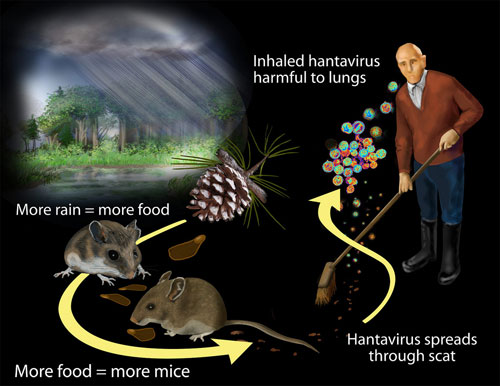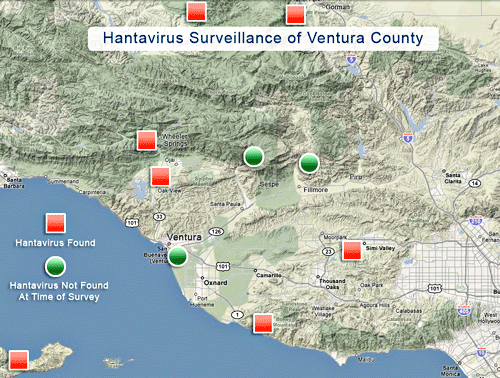Hantavirus
Hantavirus infection is a serious, life-threatening illness. A person can become infected by direct contact with infected rodents or by inhaling airborne particles of urine, droppings, or saliva from them. Dogs and cats are not known to be reservoir hosts for Hantavirus; however, they may bring infected rodents into contact with humans. The best protection against the Hantavirus is to prevent all rodents from entering structures and to carefully clean and disinfect indoor areas currently or previously infested with rodents.
The primary carrier of the Hantavirus is the Deer Mouse, Peromyscus maniculatus. The Deer Mouse is the size of a house mouse; ranges in color from pale gray to reddish brown; has white fur on its belly and feet; and has a bi-colored tail (pale gray to reddish brown and white), slightly shorter than its head and body length.
The deer mouse is commonly found in forests, brush, grasslands, and chaparral areas throughout California.
State and local health agencies have tested several thousand deer mice throughout the State and found average 12% positive for Hantavirus. Following is a map of locations of Hantavirus surveillance in Ventura County.
Who is at risk?
- People who live in structures infested with deer mice.
- Campers and hikers visiting areas infested with deer mice.
- Individuals who clean barns, out-buildings, or other storage areas where deer mice are likely to live.
- Electricians, plumbers, or others who work in crawl spaces in structures located where deer mice are commonly found.
What are the symptoms?
People infected with Hantavirus may have symptoms that include:
- fever (101-104 degrees F)
- body aches
- chills
- troubled breathing
Since Hantavirus can cause serious illness, you should contact your physician if you become ill after being in areas thought to be infested with deer mice.
What measures can I take to reduce Hantavirus exposure?
Prevent Entry, Trap, And Dispose
- Secure your house and other structures. Use steel wool, cement, or 1/4″ wire mesh to seal, screen, or cover all holes in your house, cabin, or outbuildings. Rodents can enter a structure through a hole the size of a penny!
- To keep rodents from digging, place 3 inches of gravel around the base of homes and trailers.
- Enclose the foundations of adobe, earthen, or wooden homes with metal roof flashing buried 6 inches deep and rising 12 inches above the ground.
Eliminate Rodents
- Bait snap traps with peanut butter and trap for 1 week, or until no more rodents are caught. The traps should be placed where pets, other animals, or children can not access them.
- Always spray disinfectant on dead rodents, traps, nests, droppings, spilled foods, or areas where rodents have been. Because rodents carry fleas, it may also be necessary to treat areas with flea killer.
Disposal
- Use rubber gloves or plastic bags to carefully remove dead rodents. Spray rodents and traps thoroughly with disinfectant. Place rodents in a plastic bag and seal the bag.
- If rubber gloves are not available, invert a plastic bag over your hand, pick up the rodent with the inverted plastic bag, then pull the bag around the rodent and seal. Dispose of the bag in a well-sealed garbage container.
Follow Up
- Disinfect, re-bait, and reset all traps. Wash gloved hands with disinfectant.
- When finished trapping, thoroughly disinfect all traps and place in bright sunlight until dry.
Keep Clean
- Wash dishes and clean up any spilled food immediately after cooking or eating.
- Store all food, water, and garbage in metal or thick plastic containers with tight-fitting lids.
Outside Control
- Cut grass and weeds; trim brush within 100 feet of the house, cabin, or outbuildings.
- Move woodpiles, gardens, trash cans, and animal feed away from the house.
- Place trash and animal feed in rodent-proof containers with tight-fitting lids.
- Store woodpiles, hay, and other materials at least 12 inches off the ground and 18 inches away from the buildings.
- Place spring-loaded traps and outdoor rodent poison where rodents might live.
Please Note: The instructions on the labels of all insecticides and rodenticides must always be followed. - Do not leave pet food or water in feeding dishes overnight.
- When cleaning areas where rodents have been, follow the procedures for disinfecting described below.
Disinfect
- Always disinfect with a commercial disinfectant or with a solution of household bleach and water mixed with at least 1 part bleach to 9 parts water.
- OPEN ALL DOORS AND WINDOWS TO THOROUGHLY AIR OUT BEFORE CLEANING.
- CDC Webpage on Cleaning Up After Rodents
Clean Floors
- Mop or spray floors with a disinfectant.
- To minimize dust carrying the Hantavirus, DO NOT vacuum or sweep bare floors.
- Commercially steam clean or shampoo carpets.
Clean Surfaces
- Clean counters, cabinets, drawers, or other surfaces with a disinfectant.
Clean Furniture
- Steam clean or shampoo cloth furniture.
Wash Bedding and Clothing
- Wash bedding and clothing with hot water and detergent. Place in a hot dryer or hang outside in the sun until dry.
How can I protect myself?
- When cleaning rodent infested areas, wear rubber gloves, disposable dust mask, goggles, and protective clothing, such as coveralls, rubber boots, or disposable shoe covers.
- Personal protective gear should be decontaminated upon removal at the end of the day. If the coveralls are not disposable, they should be laundered on-site. If laundry facilities are not available, the coveralls should be immersed in liquid disinfectant until they can be washed.
- Appropriate respiratory protection device, such as a half-mask air-purifying respirator with a high-efficiency filter, may be necessary in high-risk settings, such as seldom used cabins, sheds, and out-buildings, especially those with numerous rodent hiding or nesting places.
- Avoid camping near rodent droppings, burrows, and wood piles.



